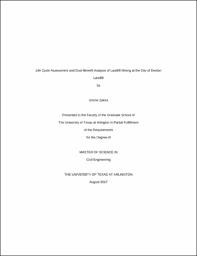
ATTENTION: The works hosted here are being migrated to a new repository that will consolidate resources, improve discoverability, and better show UTA's research impact on the global community. We will update authors as the migration progresses. Please see MavMatrix for more information.
Show simple item record
| dc.contributor.advisor | Hossain, Sahadat | |
| dc.creator | Zakira, Umme | |
| dc.date.accessioned | 2019-10-23T15:59:38Z | |
| dc.date.available | 2019-10-23T15:59:38Z | |
| dc.date.created | 2017-08 | |
| dc.date.issued | 2019-10-23 | |
| dc.date.submitted | August 2017 | |
| dc.identifier.uri | http://hdl.handle.net/10106/28729 | |
| dc.description.abstract | The concept of landfill mining has evolved the way of transforming the existing landfills from a final waste disposal site to a temporary storage location for the potentially valuable resources. The convergence of the sustainable material management and environmental protection issues have emerged the demand for the feasibility study of the landfill mining both in environmental and economic aspects considering the scope of potential resource recovery. Few studies have been conducted either on the environmental impacts on waste management (especially incineration) and operational options or generalized cost-benefit estimation for landfill mining project. Therefore, the present study aims to evaluate both the environmental and economic feasibility of an unlined cell (cell 1590A) of the City of Denton Landfill (Texas) which is containing approximately 2.6 million tons of Municipal Solid Waste (MSW) for around 30 years. Life Cycle Assessment (LCA) and Cost-benefit Analysis (CBA) has been adopted as analyzing tools for the environmental and economic studies respectively. Two landfill mining alternatives (mining with waste relocation and mining with material recovery) were compared with no-mining (do-nothing) condition for both of the approaches. Comparative LCA results showed that the mining of 1 ton of MSW with material recovery can reduce about 0.1 million kg of equivalent CO2 than no-mining condition of landfill which worth of removing about 21 thousand cars from road per year. In cost benefit analysis the landfill mining with material recovery has been found to achieve a benefit to cost ratio of 2.20 gaining $37.4 million of total net benefit which worth a total Net Present Value (NPV) of $34.1 million in 10 years of project period. Therefore, the landfill mining with material recovery has been found to be most feasible options among the alternatives in both environmental and economic analysis. Separate LCA studies have been conducted to assess the energy saving potential of reusing the mined papers and plastics instead of virgin materials for producing plastic lumber and paperboard respectively. The reusing of mined plastics and papers have been found to save 1.8 million MJ and 2300 MJ of energy respectively for 1 ton of functional unit of product. It can also reduce about 0.4 million and 1300 kg of equivalent CO2 as well for 1 ton of plastics and papers respectively which is worth of removing 85 thousand and 276 cars from road per year respectively.
Although the environmental and economic profiles of landfill mining would vary from case to case, the results of these analyses can be used as a baseline for future landfill mining projects. | |
| dc.format.mimetype | application/pdf | |
| dc.language.iso | en_US | |
| dc.subject | Landfill mining | |
| dc.subject | Life cycle assessment | |
| dc.subject | Cost-benefit analysis | |
| dc.title | LIFE CYCLE ASSESSMENT AND COST-BENEFIT ANALYSIS OF LANDFILL MINING AT THE CITY OF DENTON LANDFILL | |
| dc.type | Thesis | |
| dc.degree.department | Civil Engineering | |
| dc.degree.name | Master of Engineering in Civil Engineering | |
| dc.date.updated | 2019-10-23T15:59:39Z | |
| thesis.degree.department | Civil Engineering | |
| thesis.degree.grantor | The University of Texas at Arlington | |
| thesis.degree.level | Masters | |
| thesis.degree.name | Master of Engineering in Civil Engineering | |
| dc.type.material | text | |
| dc.creator.orcid | 0000-0001-6259-4009 | |
Files in this item
- Name:
- ZAKIRA-THESIS-2017.pdf
- Size:
- 5.377Mb
- Format:
- PDF
This item appears in the following Collection(s)
Show simple item record


